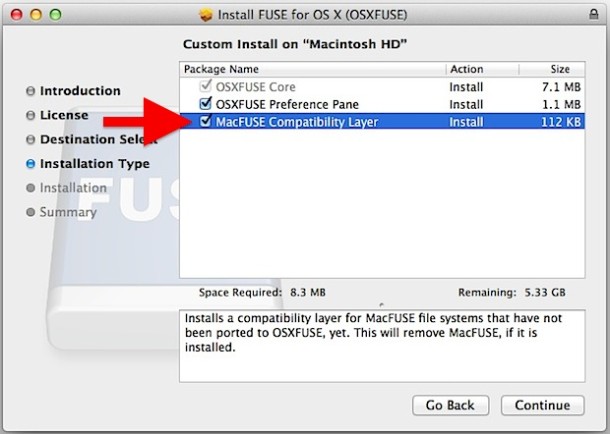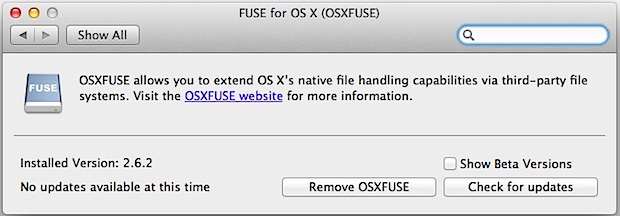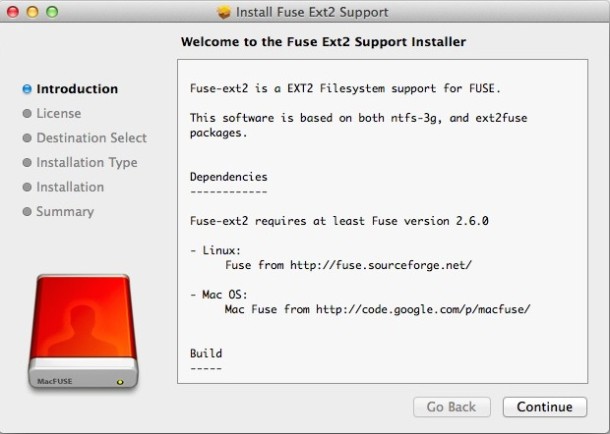How to Mount EXT4 Linux File Systems on a Mac with OS X Fuse
 The EXT file system (short for Extended File System) and it’s family members of EXT2, EXT3, and EXT4, are the file systems used by Linux and Raspberry Pi. Mac users who work with multiple platforms may notice that OS X is unable to mount EXT partitions on its own, and thus anyone wishing to mount and read EXT drives and other file systems will need to rely on a third party utility.
The EXT file system (short for Extended File System) and it’s family members of EXT2, EXT3, and EXT4, are the file systems used by Linux and Raspberry Pi. Mac users who work with multiple platforms may notice that OS X is unable to mount EXT partitions on its own, and thus anyone wishing to mount and read EXT drives and other file systems will need to rely on a third party utility.
OSXFuse is one such tool, a free open source offering that allows OS X to read EXT volumes, and if you’re comfortable with some uncertainty and risk to the Linux partition, you can even enable an experimental EXT write function too.
- Get OSXFuse from the developer (free) and run the package installer
- Choose to install the “MacFUSE Compatibility Layer”, this is optional but necessary for FUSE-EXT2
- Reboot the Mac when installation is finished, you’ll find the “Fuse for OS X” control panel in System Preferences


At this point you can connect EXT file system drives and/or partitions from the Linux world to the Mac and be able to read data from them as expected. That means you can access files and copy files from the EXT volume over to the Mac, but not vice versa (more on using EXT write support in a moment).
When EXT drives are mounted with FUSE, the volumes are interpreted as network drives or servers, so if you are hiding desktop icons or connected servers from Finder preferences you won’t see it except in a Finder window sidebar.
Longtime OS X users may recognize OSXFuse as the successor to the now defunct MacFUSE, which, once upon a time, was necessary to gain Windows NTFS support on the Mac as well. Of course, now you can just enable NTFS write support on Macs directly without the need for any third party tools, but not too long ago that wasn’t the case.
Enabling EXT Write Support
While OSXFuse adds EXT read support, write support to EXT is disabled by default and probably not recommended to use at all, it’s considered experimental and unsupported by FUSE for a reason.
Nonetheless, if you absolutely have to write to a Linux partition from OS X and you have a backup of the data and/or drive in question, and you don’t mind potentially toasting the data on the drive, you can enable writing to EXT with the following steps:
- Get FUSE-EXT2 and install it onto of MacFUSE
- Reboot the Mac, then use following command string to enable write support:
- Cross your fingers and hope for the best, this is experimental and not recommended for a reason

sudo sed -e 's/OPTIONS="auto_xattr,defer_permissions"/OPTIONS="auto_xattr,defer_permissions,rw+"/' -i .orig /System/Library/Filesystems/fuse-ext2.fs/fuse-ext2.util
Again, enabling EXT write support is not recommended. This can’t be overstated enough. Be sure to understand there are considerable risks to the drive and it’s quite possible to damage the Linux partition or drives file system by doing so. Do not do this without a backup.
By the way, an alternative for those who wish to safely read and write files between OS X and Linux (and Windows for that matter) by using an external drive are probably better off formatting a drive for maximum compatibility with the MS-DOS file system, which can be accessed by just about every operating system out there. This is particularly helpful for USB thumb drives and external disks that you want to use for quick file storage and sharing outside of a network. Otherwise, networked computers can just use the SMB protocol and share files between Mac OS X, Linux, and Windows over a local network connection. No, it’s not the same as mounting an existing EXT file system, but it works if the only intention is to be able to read and write data between different OS’s.
Uninstalling OSXFuse
The easiest way to uninstall OSXFuse is by using the packages control panel:
- Head to System Preferences by way of Apple menu and choose “Fuse for OS X”
- Click the “Remove OSXFuse” button and enter the admin password to uninstall FUSE from the Mac
Removing OSXFuse obviously removes the ability to mount all EXT linux file systems from the Mac. You will want to uninstall the FUSE packages from OS X if you intend on using one of the other third party EXT mounting solutions out there, whether from Paragon or elsewhere.


Never mind. I’ve struggled for weeks but this tool does not seem to be actively supported. It may work (or may not) with current OSX but the installation instructions are ambiguous and incomplete. The problems do not seem to be debug-able without support, except at the source code level of course.
I bought the Paragon ExtFs native filesystem driver from their website for $20. It works. It is supported. Since it is native OSX can automatically mount drives and partitions when they are inserted. No opaque terminal based manual mounting commands required. I plugged in an SD card loaded with a Raspberry PI image and all partitions showed up on the desktop.
How did you get Paragon ExtFS for Mac for $20? That would make it a no-brainer for me. But, the $50 price tag has me searching for alternative set ups on my newly resurrected dual-boot Macbook Air.
My volume is a fresh ‘jetdrive’, and I have other machines to use til I ‘move in’ to this one. So, I can be a little picky. I’ve looked into ZFS which sounds nice, but a pain to set up and maintain. Then there’s the several one-way options, which are just not useful enough. Also, the non-journaling route is possible, but with this drive being the main storage for documents and media, and it’s technically an SD card, I’m not too keen on reducing its robustness.
I am running the Paragon trial right now, and it just works, which is nice. I just wish is was $20 instead of $50. I am a poor dev Dad with so many diapers to buy. :P
I believe I followed the install instructions including rebooting. (actually installed it two ways, described above and using homebrew) I see fuse in system preferences. I then inserted an sd card formatted for raspberry pi. diskutils shows in the info window the expected two partitions, “boot” and “linux” (I believe the “linux” partition is an ext3 partition.) “boot” has been automounted. It can be seen with the ‘df’ command. However diskutils only shows “boot” in the list of drives on the left. I can mount and unmount “boot”. The other partition is ignored. What is wrong? How do I debug this?
I am on OS X 10.11.2 Installation of Mac Fuse works, but installation of fuse-ext2 fails saying it isn’t compatible. This results in the same error that Alex and Alan are facing with the OS recognizing a disk is plugged in, but no access of any kind to the files.
Current official docs are here:
https://github.com/osxfuse/osxfuse/wiki
info for installing and configuring each filesystem that fuse supports(including ext and NTFS) is all there.
if you can’t install this, then I’d suggest you don’t call yourself a Linux Admin. Even a basic one.
Read the current documentation for the software, and it works just fine.
Works for me. After a day of trying to fix Linux (Debian) permissions to transfer files to a USB (and failing) I’m happy to have my work back on a mac so that I can finish it more quickly. Installed it, opened Disk Utility and chose ‘Mount’ from the top of the window. All the Linux partitions mounted and I was able to copy the files that I needed across to the mac.
Problem that I see is that as files are viewable both ways (Debian Mac) then an issue in either could mean that your files in both were exposed. So for that reason I think I’ll discard the dual boot idea.
Alan is right.
It DOES NOT WORK!… my internal drives are not showing up at all!
No configuration, no gui or whatsoever to configure or debug…. this software is a piece of crap.
Save your time and don’t install it. Its useless!
EXT4 mounting works great! It works fine for everyone but two named “Alex” and “Alan” who can’t figure out how to mount EXT4 file systems with easy instructions! User error, typically the problem.
I’m a -basic- Linux admin, but I prefer Mac and this IS NOT WORKING! My God, how hard is it to include whatever script it takes to make this thing work as part of the installer? I mean come on, these people are supposed to be programmers. The program sucks worse than crappy software if people can’t get it to run. I’m not a super-Linux genius, but I’m also very far from a noob.
Not sure who I hate more OSXFuse or just the fuse-ext2 part, but this does NOT work. Save your time and run a Linux VM.
I guess you are not as far from a noob as you think you are? ;) works just fine for me.
this is an old post or reply but when I landed to fuse OSX, this was suppose to solve my problem. Unfortunately its not working for me same like many other users. May be its working but not for me. People here asking rating us noob bla bla but why can’t you just put a few simple steps on how this can be worked for us rather than calling by such names. be productive rather than just pin pointing. Yes may be we are not as smart you are but still as a courtesy either help us or don’t reply just keep quite.
I’ve installed Paragon ExtFS for Mac and it seems to work fine! Read-Write access to ext2/3/4 with reasonable performance.
nope either!
Installed both Fuse+Compatibility layer, reboot, and still cannot read/mount an ext4 USB stick :-(
(Latest Yosemite 10.10)
It works after installing fuse-ext2
Yep, running 10.10.1 and after installing OSXFuse with the compatibility layer and fuse-ext2 I was able to mount my old Ubuntu partition with no problems. :D
Yes, it works!
.- ATENCION: No conectar el disco Linux, yet!
Descargar e instalar OSXFuse, reiniciar el Mac,
Descargar e instalar fuse-ext2, reiniciar el Mac.
:Insertar disco Linux. Voila!
Doesn’t work for me, with both or either installed. Sees the disk in Disk Utility, but will not mount. Running 10.9.5.
The second part is misleading. Fuse-Ext2 is for ext2 and ext3, not ext4. I succeeded by first installing OSXFuse, then Homebrew(from http://www.brew.sh) and then opening terminal and typing(without double qotes)”brew install ext4fuse”. You may reboot in between. I did.
That’s correct.
This didn’t work for me either so I kept Googling. Turns out these instructions are misleading in that it says to install FUSE-EXT2 if you want write access to EXT2/3/4. You need to install FUSE-EXT2 for read access. Write access if only active if you also run the command line listed above. Works for me now, using a USB HD formatted to EXT4.
Well it is August 2014 now. Has anyone come up with a solution? It is not working for me either.
Installed, but I have no idea how I’m supposed to “connect EXT file system drives and/or partitions from the Linux world to the Mac and be able to read data from them as expected.” More details would be helpful…… How to do mount the partitions? Where do I go to do that? Thanks.
Nope -doesn’t work for me either. I have version 2.6.4 and OS X 10.9.2, and I get the ‘disk not readable error’. Just the same as before installation.
Any assistance would be appreciated.
My Tivo failed and I wanted to save some recordings so I removed the drive and plugged it into a drive slot in my MacPro 5.1 running OSX10.6.8. I used a utility to determine that it was formatted as a LINUX EXT2 volume. Using your suggestion above, I downloaded OSXFuse, selecting MacFUSE Compatibility Layer, and installed the software. I restarted the Mac but the Linux volume did not mount. I can see the volume in Disk Utility, but it is grayed out, along with each of its partitions.
What am I doing wrong?
WAH
I’ve used this software in the past, and it brought me my first (and last) two kernel panics ever.
It might have been an isolated case and/or fixed since then… But just a heads up to anyone trying it.
Don’t leave any unsaved work open when fiddling with this.
I have had the same experience a long time ago when using MacFUSE where you’d get a kernel panic when simply connecting an EXT volume! Boom, Mac kernel panic. But I suspect that has been resolved by now with OSXFuse and further refinement, though I no longer have a use-case for this and don’t have a reason to test it.
But yes I agree with your sentiment: back up everything before trying out experimental file system support! That means both on the Mac, and on the alternate FS drive!
i’m using this software instead ftp client, and I must say that is working just fine.